Related Research Articles

The chicken is a large and round short-winged bird, domesticated from the red junglefowl of Southeast Asia around 8,000 years ago. Most chickens are raised for food, providing meat and eggs; others are kept as pets or for cockfighting.
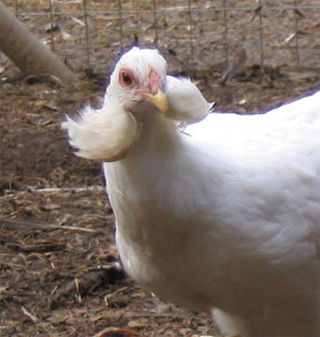
The Araucana is a breed of domestic chicken from Chile. The name derives from the historic Araucanía region where it is believed to have originated. It lays blue-shelled eggs, one of very few breeds that do so.
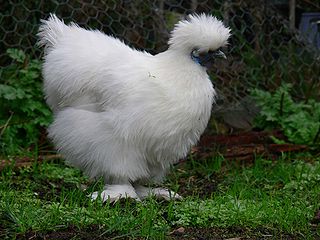
The Silkie is a Chinese breed of chicken named for its atypically fluffy plumage, which is said to feel like silk and satin. The breed has several other unusual qualities, such as black skin and bones, blue earlobes, and five toes on each foot, whereas most chickens have only four. They are often exhibited in poultry shows, and also appear in various colors. In addition to their distinctive physical characteristics, Silkies are well known for their calm and friendly temperament. It is among the most docile of poultry. Hens are also exceptionally broody, and care for young well. Although they are fair layers themselves, laying only about three eggs a week, they are commonly used to hatch eggs from other breeds and bird species due to their broody nature. Silkie chickens have been bred to have a wide variety of colors which include but are not limited to: Black, Blue, Buff, Partridge, Splash, White, Lavender, Paint and Porcelain.

The red junglefowl, also known as the Indian red junglefowl, is a species of tropical, predominantly terrestrial bird in the fowl and pheasant family, Phasianidae, found across much of Southeast and parts of South Asia. The red junglefowl was the primary species to give rise to today's many breeds of domesticated chicken ; additionally, the related grey junglefowl, Sri Lankan junglefowl and the Javanese green junglefowl have also contributed genetic material to the gene pool of the modern chicken.
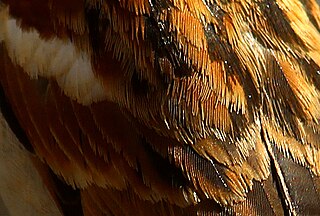
Plumage is a layer of feathers that covers a bird and the pattern, colour, and arrangement of those feathers. The pattern and colours of plumage differ between species and subspecies and may vary with age classes. Within species, there can be different colour morphs. The placement of feathers on a bird is not haphazard but rather emerges in organized, overlapping rows and groups, and these feather tracts are known by standardized names.

The gray junglefowl, also known as Sonnerat's junglefowl, is one of the wild ancestors of the domestic chicken together with the red junglefowl and other junglefowls.

The green junglefowl, also known as Javan junglefowl, forktail or green Javanese junglefowl, is the most distantly related and the first to diverge at least 4 million years ago among the four species of the junglefowl. Hybridization with domestic chicken has also been reported. Green junglefowl is a medium-sized bird in the pheasant family Phasianidae.

The Yurlov Crower is an old Russian breed of chicken primarily selected and used for long crowing cock contests in Russia.

The Bekisar, or Ayam Bekisar, is the first-generation hybrid offspring of the green junglefowl and domesticated red junglefowl from Java. The roosters have a glossy blackish-green plumage and are highly prized for their loud clear calls and striking colouration, while the hens are usually dull and infertile.

The Sumatra is a European and North American breed of chicken. It derives from birds imported in the nineteenth century from the island of Sumatra in Indonesia as fighting cocks.

The Sebright is a British breed of bantam chicken. It is a true bantam – a miniature bird with no corresponding large version – and is one of the oldest recorded British bantam breeds. It is named after Sir John Saunders Sebright, who created it as an ornamental breed by selective breeding in the early nineteenth century.

The Naked Neck is a breed of chicken that is naturally devoid of feathers on its neck and vent. The breed is also called the Transylvanian Naked Neck, as well as the Turken. The name "Turken" arose from the mistaken idea that the bird was a hybrid of a chicken and the domestic turkey. Naked Necks are fairly common in Europe today, but are rare in North America and very common in South America. The trait for a naked neck is a dominant one controlled by one gene and is fairly easy to introduce into other breeds, however these are hybrids rather than true Naked Necks, which is a breed recognized by the American Poultry Association since 1965, it was introduced in Britain in the 1920s. There are other breeds of naked necked chicken, such as the French naked neck, which is often confused with the Transylvanian, and the naked necked gamefowl.
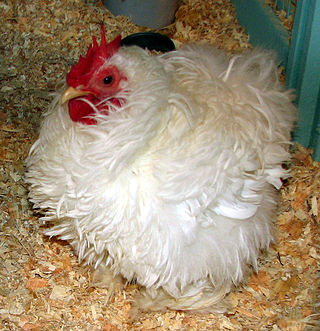
A frizzle refers to a plumage pattern in domesticated chickens characterized by feathers that curl outwards, rather than lying flat as in most chickens. The frizzle type is not a separate breed, but a variety within breeds. Though all breeds of chickens may be frizzled; it is most commonly seen in breeds such as the Cochin, Pekin, and Polish. Chickens with this pattern are sometimes referred to as frizzles. The gene which causes the frizzles' peculiar feathering is an incomplete dominant trait.

The Buckeye is an American breed of chicken. It was created in Ohio in the late nineteenth century by Nettie Metcalf. The color of its plumage was intended to resemble the color of the seeds of Aesculus glabra, the Ohio Buckeye plant for which the state is called the 'Buckeye State'.
The Nankin Bantam or Nankin is a British bantam breed of chicken. It is a true bantam, a naturally small breed with no large counterpart from which it was miniaturised. It is of South-east Asian origin, and is among the oldest bantam breeds. It is a yellowish buff colour, and the name is thought to derive from the colour of nankeen cotton from China.
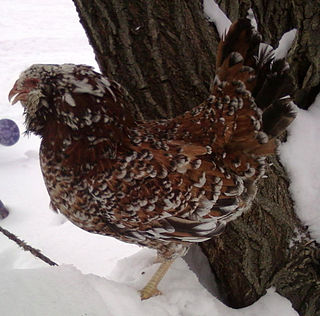
The Orloff is a breed of chicken named after Alexei Grigoryevich Orlov, a Russian Count. Reflecting this origin, it is sometimes called the Russian Orloff or simply Russian.
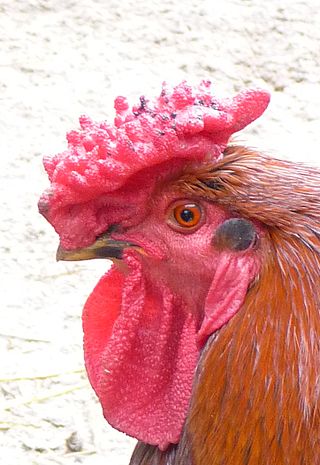
The Derbyshire Redcap is a breed of chicken originating in the English county of Derbyshire. The name "Redcap" derives from the breed's unusually large Rose-type comb. British breed standards dictate a length of more than 7 centimetres (3 inches) of length for a Redcap comb. It is covered in small, fleshy points, and has a distinct spike pointing backwards called a "leader". Combs, wattles and earlobes are all ideally bright red.

Hen feathering in cocks is the occurrence of a genetically conditioned character in domestic fowl. Males with this condition develop a female-type plumage, although otherwise look and respond as virile males.

Long-crowing chicken breeds are characterised by the unusually long-drawn-out crow of the cocks, which may in some cases last for up to 60 seconds. The oldest references to long-crowing cocks are from China. Long-crowing breeds are found in the Far East, in Turkey, in the Balkans and in western Germany.
References
- ↑ Arlina, Firda; Ahmad, Dasmi; Afriani, Tinda; Madina, Lany (February 2007). "Characterization of Number of Crow and Qualitative Marker of Kokok Balenggek Song Fowl Inside a Captive Breeding Farm in Solok Regency, West Sumatera Province, Indonesia". Jurnal Peternakan Indonesia. 12 (1): 12–17. doi: 10.25077/jpi.12.1.12-17.2007 .
- ↑ Arlina, Firda; RUSFIDRA; Andriano, Dicky; Sumatri, Cece (2020-04-13). "Short Communication: The type and sound diversity of Kukuak Balenggek chicken (Gallus gallus domesticus) reared in West Sumatra, Indonesia". Biodiversitas Journal of Biological Diversity. 21 (5). doi: 10.13057/biodiv/d210518 . ISSN 2085-4722. S2CID 219073879.
- ↑ "Population Structure of Kokok Balenggek Chicken in In-situ Area as Indigenous Chicken of Indonesia". researcherslinks.com. Retrieved 2023-09-15.
- ↑ "Mengenal Ayam Kokok Balenggek dari Sumatera Barat yang Bersuara Unik". Tempo. 2023-06-19. Retrieved 2023-09-20.
- ↑ Arlina, Firda; Abbas, Hafil; Anwar, Sarbaini; Jamsari, Jamsari (2017-11-24). "Qualitative And Quantitative Traits of Kokok Balenggek Chicken, the Rare Indigeneous [sic] Chicken in West Sumatera". International Seminar on Tropical Animal Production: 453–457.
- ↑ Damerow, Gail (20 February 2010). Storey's Guide to Raising Chickens. North Adams, MA: Storey Publishing. p. 44. ISBN 9781603424707.